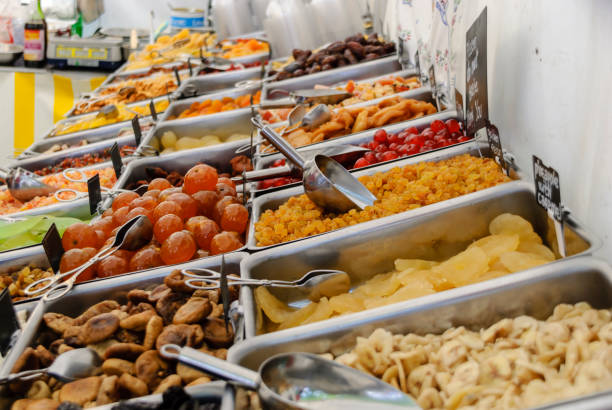If you’ve ever faced an all-you-can-eat buffet with sheer determination to conquer mounds of delicious food, only to wave the white flag after a few rounds, you’re not alone. It’s easy to blame your voracious appetite, but there’s more to the story. Behind the scenes in the kitchen and strategically designed dining halls, a series of tactics come into play to influence the quantity and speed at which you consume food. This article will expose some of the tricks used by all-you-can-eat buffets, revealing how they influence your dining choices and leave you feeling overly stuffed.
1. Controlled Portions
Although all-you-can-eat buffets seemingly offer unlimited food, they are masters at influencing your choices. While you enjoy the freedom to select a wide array of dishes, buffets steer you toward filling, low-cost options. When you visit a buffet, you’ll notice salads and sides presented generously, while premium items like lamb roast are carefully controlled by servers. This approach ensures that you fill up quickly, saving the buffet money. Thus, you’re more likely to indulge in appetizers rather than requesting a server for more expensive dishes.
2. Purposeful Utensils
The utensils you use at buffets are not random choices. Oversized spoons are used for inexpensive, filling foods like vegetables, while smaller tongs are reserved for pricier items such as meat. Smaller plates and bowls encourage multiple trips to the buffet, creating the illusion of fullness despite smaller portions. Buffets even employ utensils designed to slow your eating pace. For example, smaller forks make you eat more slowly, leading to quicker fullness. Offering chopsticks at Asian buffets is another strategy to make dining more challenging, especially for those unfamiliar with using them.
3. Beverage Tricks
Buffets play a beverage game that often goes unnoticed. Large glasses encourage more liquid consumption, filling you up on the cheapest item offered: water. Additionally, sugary drinks with high-calorie content add to the fullness illusion, as they’re sold separately at marked-up prices. The “free refills” strategy ensures you keep sipping, ultimately contributing to your sense of being full. This approach boosts the restaurant’s profits while making you feel satiated faster.
4. Strategic Food Placement
Although buffets appear as culinary wonderlands, their layout is intentionally designed to influence your choices. Cheaper, filling options like vegetables and rice are placed at the beginning of the buffet, along with salad bars tempting you to load up on cost-efficient items. Expensive dishes, such as steaks and seafood, are challenging to find, concealed by cheaper fare, or brought out only when diners are too full to indulge.
5. Abundance of Choices
The wide variety of dishes at buffets tempts your curiosity and instinct to try new flavors. This approach encourages continuous plate refills, making it easy to lose track of what you’ve eaten. The diversity of colors, aromas, and textures stimulates your appetite, making it challenging to monitor your consumption amidst the plethora of choices. The buffet’s strategy is to lead you to eat beyond your usual limits by encouraging you to try a bit of everything.
6. Quick Satisfaction with Starchy Foods
Starchy foods like potatoes, rice, pasta, and bread are buffet staples designed to satiate you quickly and cost-effectively. These inexpensive fillers contain carbohydrates that break down into glucose, triggering a rapid feeling of fullness. Paired with the illusion of providing nutritional value, these low-cost fillers encourage you to consume more, eventually leaving you feeling overly full.
7. Creamy Dishes for Rapid Fullness
Buffets offer creamy, calorie-dense dishes loaded with high-fat ingredients. Soups, stews, and pasta frequently contain fattening sauces paired with carbs and fiber-rich foods like potatoes and beans. The liquid content of these dishes promotes a longer-lasting sense of fullness, encouraging diners to consume more. However, these seemingly innocent dishes may hide unhealthy fats and high-calorie content. Choosing alternatives or moderating your consumption is crucial to prevent rapid overindulgence.
8. Cheap Greens Galore
Buffets prioritize cost-efficient ingredients like vegetables and proteins. While the abundance of vegetables might seem costly, it’s a clever cost-minimizing tactic that promotes quick satiation. You’ll find vegetables like lettuce, spinach, and proteins such as chicken and pork frequently available, as they are inexpensive when bought in bulk. Although they add volume to your plate, they contribute to that feeling of fullness buffets are notorious for.
